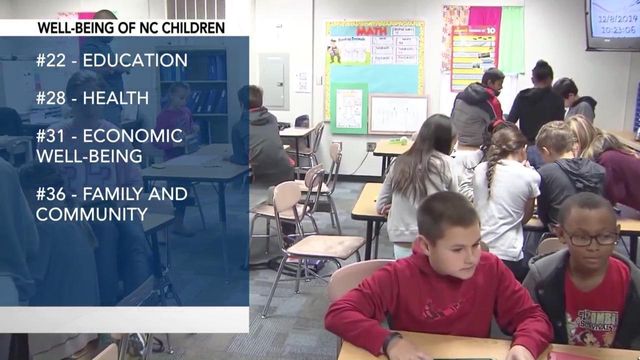Report: NC ranks 33rd in child well-being, made 'mixed progress' on health, poverty, education
North Carolina has seen a boom in its youth population, with 2.3 million children currently living in the state, but "greater investments must be made to programs that promote children’s health and development, school success, and family financial stability, such as expanding access to early childhood education," according to a new report released Monday.
The 2019 KIDS COUNT Data Book by the Annie E. Casey Foundation examined 16 measures of child well-being in four categories, ranking states from 1 to 50. North Carolina ranks 31st in economic well-being, 22nd in education, 28th in health and 36th in family and community. North Carolina ranks 33rd in overall child well-being.
The report found that a significantly higher percentage of North Carolina 3- and 4-year-olds are enrolled in school now than in 1990, when the group released its first report, but "progress has stalled in recent years with a lack of investment." The percentage of North Carolina’s 3- and 4-year-olds enrolled in some form of school dropped in the most recent report, "after two decades of significant improvement."
North Carolina lawmakers recently heard a report about early education. A study by the North Carolina General Assembly's Program Evaluation Division said the state should focus on early childhood learning to raise achievement in predominantly disadvantaged school systems.
Close to half a million North Carolina children now live in poverty, and serious racial and ethnic disparities persist, according to the Kids Count report. Black and Latinx children in North Carolina are more likely to live in areas of concentrated poverty, and in families that spend more than 30 percent of their monthly income on housing.
In April, a report by the National Institute for Early Education Research found that North Carolina has increased state preschool funding and enrollment, but access has hovered at 23 percent of 4-year-olds – below the national average.
The State of Preschool 2018 annual report, based on 2017-18 academic year data, found that North Carolina boosted pre-K spending by nearly $6 million in 2017-18, with plans to continue increased funding. However, the state "needs to both expand access and restore funding per child to pre-recession levels to help close the pay gap between pre-K and K-3 teachers with the same qualifications," the group wrote.
The fastest-growing population of young children in North Carolina is Latinx children, who now make up 16 percent of North Carolina’s child population. They are the same population most at risk of being missed in the 2020 census, according to a recent report by NC Child.
“We truly can equip all kids to succeed in school and beyond,” Michelle Hughes, executive director of NC Child, said in a statement. “But to make that vision a reality, we need to tackle the racial and ethnic disparities head on, and dismantle the obstacles that children of color encounter on the road to adulthood.”
The Casey Foundation and NC Child point to areas of improvement – including access to health care, decreased rates of teen childbearing and increased rates of high school graduation. The Casey Foundation is calling on elected officials and representatives to:
- Expand the programs that make and keep kids healthy. For the sake of all children, regardless of their immigration status, states should close the “coverage gap.” Parents, and people who will become parents, need access to quality, affordable health coverage in order to have healthy babies and care for their children. Parents’ health coverage also supports family stability and financial health.
- Provide the tools proven to help families lift themselves up economically. Federal and state earned income tax credits (EITC) and child tax credit programs mean working parents can use more of their take-home pay to meet their children’s needs.
- Address ethnic and racial inequities. The national averages of child well-being can mask the reality that black and brown children still face a greater number of obstacles.
- Count all kids. Ensure the 2020 census counts all children, especially those under 5 years old and from hard-to-count areas.
The 2019 KIDS COUNT Data Book is the 30th edition of an annual data study that is based on U.S. Census and other publicly available data, representing all 50 states, the District of Columbia and Puerto Rico.













